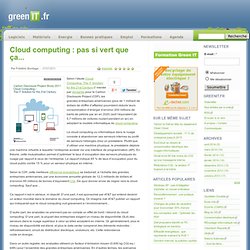

Euratechnologies sur Twitter : "Petit dej´ du @FIC_Obs de la Cybersécurité, sur le thème "#ShadowIT : la face cachée du #cloud" @ClusterCNCS. Pierre Boulet - Google+ - Le côté obscur de la force... How to Find (or Be) the Best Cloud Operations Candidate. We Recommend These Resources What does a cloud computing expert need to know?

How do you hire a cloud computing expert? Competition for operations & DBAs is fierce, so you’ll want to know how to find the best. If you’re a systems administrator or ops guy, you may want to prepare for an interview for such a position. Meanwhile, if you’re a director of it or operations, a recruiter or manager in HR, you’ll want to have some idea how to find the right candidate.
Here’s my guide to do just that. 1. At the top of the list, a cloud operations expert needs to understand Unix and more importantly Linux. O What is web operations and what have you done day-to-day? Prepare some stories. o What’s your favorite feature of the linux kernel? This is an open ended question, but a systems administrator should have some knowledge here. O Name some distributions of linux. Linux is built by a collaborative team of thousands on the internet. O What’s the difference between apache and nginx? O Command line tools 2. Is Virtualization Really a Base for Cloud? Many of you have heard this question and have different thoughts on using virtualization in cloud.

While some professionals say that virtualization is not mandatory for cloud and other say that Virtualization is the base for cloud. I am trying to answer the above question by providing a rationale for using virtualization in cloud. Before entering into a debate, let me explain Virtualization concept in simple terminology. Server Virtualization OS segregates the interaction between hardware and OS. This will help us to keep independent OSs above a single hardware. Resource pool is concepts inside the virtualization layer which will help to combine the resources (Memory and CPU) from multiple hardware's and show that as single unit to Guest OS (VM).
This diagram is simplified view for Virtualized Server. IT infrastructure is using the virtualization technology to achieve more cost benefits as it will help to consolidate and optimize the resource utilization. Eetimes. Will Marvell’s under-$30 cloud server make teachers and students Smile? We’ve seen a lot of visions over the years as to just how computers should be used in the classroom.

In my relatively well-funded district, we’ve had computer labs that kids were scheduled to visit regularly, Kindles in the library, and carts full of laptops wheeled into rooms for student use; neighboring schools are testing textbooks on iPads. For the developing world, the One Laptop Per Child (OLPC) organization has for years been working to make cheap, rugged, low-power laptops available for use in education. For the most part, all of these efforts involved buying hardware and getting it onto student desks. But earlier this week, researchers from Stanford University and Marvell Semiconductor Inc. dared to upset the conventional wisdom. They introduced a micro-cloud computer, the Smile Plug, and educational software, which they call Smile (for Stanford Mobile Inquiry-based Learning Environment, an approach already tested in 22 countries).
But enough about the hardware and software. Hébergeur › Cloud computing : pas si vert que ça... Par Frédéric Bordage - 27/07/2011 Selon l’étude Cloud Computing: The IT Solution for the 21st Century menée par Verdantix pour le Carbon Disclosure Project (CDP), les grandes entreprises américaines (plus de 1 milliard de dollars de chiffre d’affaires) pourraient réduire leurs consommation d’énergie d’environ 200 millions de barils de pétrole par an en 2020 (soit l’équivalent de 5,7 millions de voitures roulant pendant un an) en adoptant le modèle informatique du cloud computing.

Le cloud computing ou informatique dans le nuage consiste à abandonner ses serveurs internes au profit de serveurs hébergés chez un prestataire. Plutôt que d’utiliser une machine physique, le prestataire déploie une machine virtuelle à laquelle l’entreprise accède via une interface de programmation (API). En théorie, cette mutualisation permet d’optimiser le taux d’occupation des serveurs physiques du nuage par rapport à ceux de l’entreprise. Ce rapport n’est ni sérieux, ni objectif. Source : Infographie : les mises à jour de l'algorithme de Google depuis 2003.